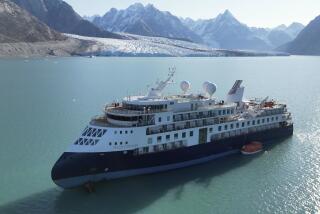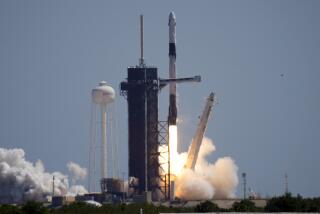Arctic Nuclear Cruise Faces Fallout : Russia: Tourists pay $16,900 for trip to North Pole on atomic-powered icebreaker. Environmental group warns of risks.
- Share via
MOSCOW — Ready for a really cool vacation? How about a 19-day cruise aboard a Russian icebreaker to the North Pole?
The price, without air fare but including champagne and a barbecue atop the ice of the North Pole: $16,900.
On Friday, a group of about 100 Western tourists sailed out of Murmansk harbor in the Russian Far North, hoping to see the kittiwakes (gulls) and walruses of Franz Josef Land, enjoy the endless daylight and unbroken solitude of the arctic summer and, finally, watch the compass swing aimlessly at the very apex of the Earth.
But there’s a hitch: The Yamal is a nuclear-powered icebreaker belonging to the Russian Atomic Fleet, now a privatized and profit-making commercial enterprise.
The adventure began even before the tourists arrived in Russia, when Norwegian environmentalists protesting “nuclear tourism” tried to block their plane from taking off from the airport in Tromso, in northwestern Norway, en route from the tour’s origin in Oslo to Murmansk.
The demonstrators from Friends of the Earth Norway begged the tourists not to take the cruise. They argued that Russia has a poor nuclear safety record, a history of accidents and nuclear dumping from its icebreakers, and no adequate storage facilities for the nuclear waste the giant ships generate.
“Nuclear power is unsure generally, but the technology used here--Russian technology developed for submarines and icebreakers in the 1950s or ‘60s--is simply dangerous,” said Arnstein Grotting, 22, a student who lay in front of the plane to make his point.
“It is immoral to use unsafe nuclear reactor technology to go on holiday to the North Pole,” Grotting said in a telephone interview from Tromso.
Grotting and seven others were arrested during Thursday’s protest. He said the attempt to block the plane was a last resort after two years of failed attempts to dissuade the tour operators, the Atomic Fleet and the tourists to stop the nuclear cruises.
The head of the American company that promotes the icebreaker tours, Quark Expeditions of Darien, Conn., did not return telephone calls requesting comment Friday.
But a Quark sales agent said the company offered a range of “eco-tours” or wildlife tours, including expeditions on non-nuclear Russian ships to the North and South Poles. Among the tours offered: a circumnavigation of the Antarctic continent aboard a conventionally powered Russian icebreaker, the Capt. Khlebnikov. The 66-day tour departs in November, 1996, and costs $37,000, and half of the 106 tickets are already sold, the agent said.
*
Quark’s agent in Oslo, Thomas Granseldt Jr. of ScanNatic, said a trip aboard a nuclear icebreaker generates less pollution than a similar expedition aboard a diesel-powered vessel. He said he agrees that nuclear waste in Murmansk poses an environmental problem but that the waste is the responsibility of the Russian Northern Fleet, headquartered in Murmansk.
According to the Norwegian environmental group Bellona, the Atomic Fleet’s seven civilian icebreakers are still owned by the state but are operated by the privatized Murmansk Shipping Co.
Friends of the Earth argues that Western money should be spent cleaning up the huge nuclear waste problem in the reactor-studded Russian northwest, not on nuclear junkets that will only support the trouble-prone nuclear industry. Granseldt said he told the tourists, “You and I should be together in front of the French Embassy, protesting the blowing up of nuclear bombs, but leave a simple icebreaker alone.” He was referring to France’s recent decision to resume nuclear weapons tests in the South Pacific.
The environmentalists accuse Quark of using misleading advertising to attract customers who have no idea of the safety and environmental risks. “The Yamal not only ranks among the world’s largest and most powerful icebreakers but also exemplifies every other aspect of technology and comfort,” the Quark brochure says. It goes on to mention the icebreaker’s 75,000-horsepower engine, the spectacular glaciers and fiords the tourists will see on Novaya Zemlya, and the saunas and gourmet food the travelers will enjoy while their vessel is plowing through ice up to 15 feet thick.
“I did not find one single word about the fact that this is a nuclear icebreaker,” said Silje Schei Tveitdal of Friends of the Earth in Oslo.
And while the brochure does discuss the rich wildlife of Novaya Zemlya, it fails to mention that the island has for decades been the main nuclear testing ground for Russia. “They have detonated over 100 atomic bombs on this island, the last one in 1990,” Tveitdal said.
Granseldt said all the tourists knew that the Yamal was nuclear-powered and that they had nothing to fear. The ship is only 2 years old, a product of the most modern technology. It received special permission to come to Norway, which ordinarily prohibits nuclear-powered vessels, he said, adding, “Norwegian scientists were on board to check it, and they were impressed.”
Tveitdal and Grotting said some tourists they spoke with were upset by the environmentalists’ information or said they would consider quitting the tour but demurred when they learned they would not get a refund. Others dismissed the environmentalists’ concerns.
Granseldt said none of the tourists were upset or demanded their money back.
*
One traveler Grotting spoke with was an American who said he had seen the North Pole underwater aboard the U.S. Nautilus submarine but would now like to see it from above ground.
Robert E. Peary and Matthew A. Henson were the first explorers to prove that they had arrived on the North Pole in 1909. But the Russians were the first to get there by ship, smashing their way in aboard the nuclear icebreaker Arktika in 1977. Atomic icebreakers have ruled the Pole ever since, because diesel-powered craft cannot carry enough fuel to power themselves through the thick ice pack.
Russian icebreakers have been making commercial runs to the North Pole since 1989, mostly for American passengers who pay up to $25,000 for the privilege.
*
Nuclear icebreakers generate only a tiny fraction of Russia’s colossal backlog of unprocessed military and civilian nuclear waste, but Russian authorities lack the money to decommission and store them safely.
For example, after a serious accident on the icebreaker Lenin in 1966, damaged components were encased in concrete on another ship, the Lepse, which is still floating in the harbor. The radioactive waste cannot be extracted and the Lepse is slowly deteriorating for lack of money to maintain it. Bellona researchers warn that if neglected, the Lepse could eventually sink, causing massive radioactive contamination.
Bellona, which has been working in Russia since 1990 and produced a comprehensive 1994 report on sources of radioactive contamination in the Russian northwest, documented four accidents aboard nuclear icebreakers since 1988. In a 1993 incident, the Arktika’s cooling system leaked, discharging radioactivity into the atmosphere for three days, the Bellona report said.
More to Read
Sign up for Essential California
The most important California stories and recommendations in your inbox every morning.
You may occasionally receive promotional content from the Los Angeles Times.












